by Mohandas K. Gandhi
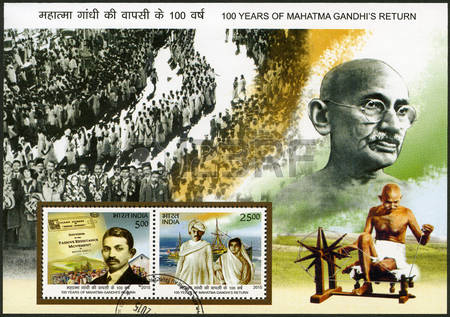
Gandhi poster commemorating his 1915 return to Indian from South Africa, courtesy www.123rf.com
Editor’s Preface: This is the last in our series of articles from the IISG/War Resisters’ International archive; it was first published in the May 3, 1946 issue of Peace News. We have selected this particular article because of Gandhi’s criticism of destruction of property, a tactic used by the Vietnam War protest movement, as with the burning of draft files. The discussion was later revisited by Occupy, and especially Occupy Oakland. Please also consult the notes at the end. JG
“I plead now for non-violence and yet more non-violence.” M. K. Gandhi
Hatred is in the air and impatient lovers of India will gladly take advantage of it, if they can, through violence, to further the cause of independence. That is wrong at any time and everywhere, but it is more wrong in a country where fighters for freedom have declared to the world that their policy is truth and non-violence.
Read the rest of this article »
by Brian Martin
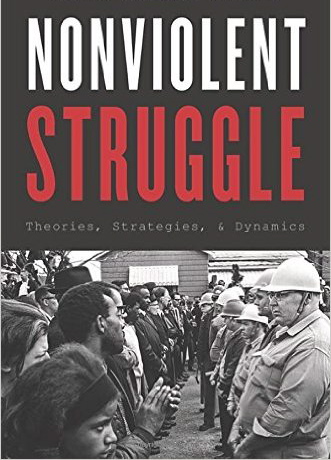
Dustwrapper for Nepstad’s book, courtesy global.oup.com
Interest in nonviolent action is greater today than it ever has been. This is reflected in the number and sophistication of nonviolent campaigns, in media coverage and popular understanding, and in new books. Several terrific new nonviolence books were published last year.
Decades ago, really good books in the area were uncommon. There was Gandhi’s autobiography, Richard Gregg’s The Power of Nonviolence (1934), and Joan Bondurant’s Conquest of Violence: The Gandhian Philosophy of Conflict (1958). These classic treatments are all in the Gandhian tradition, and each one is still worth reading today. Other favorites of mine are Bart de Ligt, The Conquest of Violence: An Essay on War and Revolution (1937), and Gene Sharp’s epic The Politics of Nonviolent Action (1973). Each of Sharp’s three parts is available separately and is a book in itself. Back in the 1970s, I read it from beginning to end, but these days many just look at Sharp’s list of 198 methods of nonviolent action. Sharp put so-called “pragmatic nonviolent action” on the agenda as an alternative or complement to the Gandhian tradition. (Please see the note at the end for bibliographical details of the above titles.)
Below I review five books published in 2015 that make important contributions to the field, and also two others published in late 2015 and in 2016. Full disclosure: I should mention that I’m not a neutral commentator. For each of the first four books, I either commented on drafts of the text or on the book proposal. As you’ll see, I think they are all excellent and worth reading. (Please see the note at the end for full details of each of the titles under review.)
Read the rest of this article »
by Terry Messman
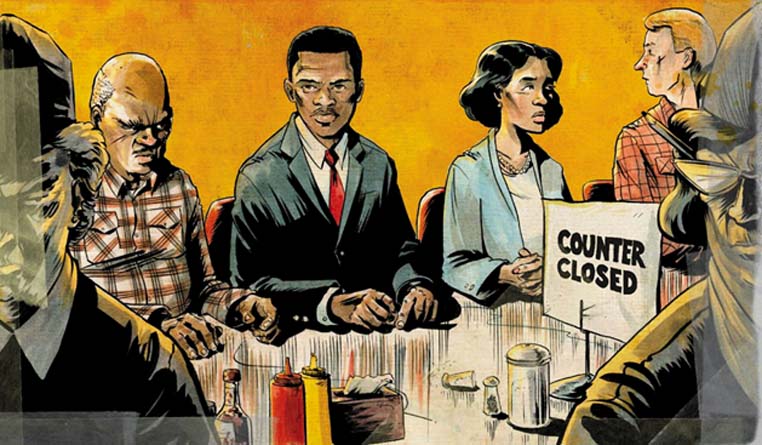
John Lewis at Nashville sit-in, book cover of March: Book One, courtesy topshelfcomix.com
Editor’s Preface: John Robert Lewis (b. 1940) is the U.S. Representative for Georgia’s 5th congressional district, and the dean of the Georgia congressional delegation. His district also includes the northern three-quarters of Atlanta. His Wikipedia page is a reliable starting point for information about his nonviolent civil rights activities and his political career. JG
It has now been 50 years since “Bloody Sunday” in Selma, Alabama, when John Lewis and Hosea Williams led some 600 civil rights marchers across the Edmund Pettus Bridge on March 7, 1965. The demonstrators attempted to march peacefully from Selma to Montgomery in support of voting rights, but state and local police viciously attacked the nonviolent procession, brutally beating them with whips and clubs, firing tear gas and charging the defenseless marchers on horseback. Hundreds of people suffered bloody beatings and some were clubbed nearly to death.
Read the rest of this article »
by Jess Clarke
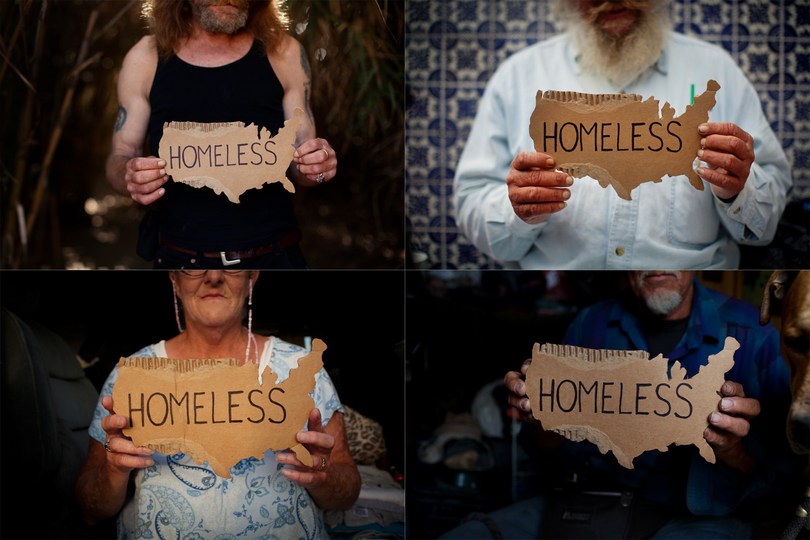
Homeless in America; image courtesy web.stanford.edu
Interviewer’s Preface: Street Spirit is one of the longest-lived publications on poverty, homelessness and human rights in the United States; it is sold by homeless vendors in Oakland and Berkeley, California, and tirelessly defends the human rights of homeless people. Terry Messman produced the first issue in March 1995, and has edited and designed every issue for nearly 22 years. Please see the note at the end for further biographical details about Messman, and interviewer Jess Clarke. JC
“What matters in the long run is staying true to the cause of justice. In the end,
that is the very meaning of our lives — whether we keep going, and keep working for peace and justice,
or give up in despair. It’s the question at the very heart of it all.” Terry Messman
Jess Clarke: As the founder of Street Spirit, you’ve seen some of the important political trends in homeless organizing and human rights advocacy in the Bay Area. Looking at the big picture, when and why did you first found Street Spirit?
Terry Messman: We put out the first issue in March of 1995, so we’ve been going steadily nearly 22 years. It’s one of the longest-lived media of any kind in the nation to document the history of poverty, homelessness, and the movements to overcome economic injustice.
Read the rest of this article »
by David Barsamian
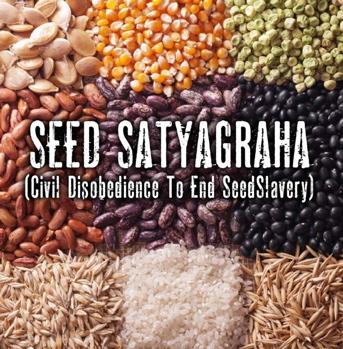
Seed Satyagraha poster courtesy navdanya.org
Interviewer’s Preface: Vandana Shiva is an internationally renowned voice for sustainable development and social justice. She spoke in New Delhi with David Barsamian, founder of Alternative Radio, during his December 2008 trip to India and Pakistan. Some say terrorism makes Gandhi irrelevant. Vandana Shiva, farmer, seed saver, and global justice activist, says we need him more than ever. Gandhi’s three pillars of freedom are now the keys to our survival. Here then are her thoughts on why Gandhi’s philosophy is still relevant—even in a world where terrorism is on the rise. Please consult the Editor’s Note at the end for biographical information about Vandana Shiva and David Barsamian. DB
David Barsamian: In the wake of the attacks on Mumbai in late November 2008, there was a piece in the (London) Sunday Express, “The Irony Gandhism Presents in Today’s Terror-Infested India.” The writer said, “It is time the government became doubly stern about its steps to combat terrorism. India may be the land of Mahatma Gandhi, but today’s situation warrants crude and cunning ways to counter extremism. That alone can ensure peace, harmony, and joy in the country.” Would you share your thoughts on this?
Vandana Shiva: Unfortunately, “crude” means of dealing with violence and terror just breed more violence and terror. As we saw after 9/11, the war on terror has created more terrorists. I think anyone who says that Gandhi is irrelevant in today’s world doesn’t understand either terrorism, its roots, or Gandhi. Suicide bombers don’t get created out of the blue; they are created as a result of decisions, systems, and processes. It’s very much like weeds in a field. One way to control weeds is by spraying Round-Up pesticides, but then you get Round-Up-resistant weeds, which are even stronger than the original weeds. That’s what is happening with terrorism.
Read the rest of this article »









